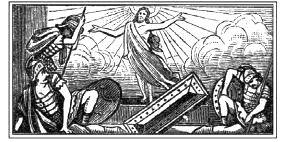
| Contents | Quem terra, pontus, aethera The God Whom Earth and Sea and Sky |
BVM |

This hymn was composed by Venantius Fortunatus (530-609), Bishop of Poitiers, and has been an important part of devotions to the Blessed Virgin Mary since the early Middle Ages. Today it is used in the Little Office of the Blessed Virgin Mary daily as a hymn for the Office of the Readings and also as the hymn for Friday Lauds. In the Liturgy of the Hours it is found in the Common of the Blessed Virgin Mary as the hymn for the Office of the Readings.
|
| QUEM terra, pontus, aethera1 colunt, adorant, praedicant, trinam regentem machinam claustrum Mariae baiulat. |
THE God whom earth, and sea, and sky adore, and laud, and magnify, who o'er their threefold fabric reigns, the Virgin's spotless womb contains. |
| Cui Luna, Sol, et omnia deserviunt per tempora, perfusa caeli gratia, gestant Puellae viscera. |
The God whose will by moon, and sun, and all things in due course is done, is borne upon a Maiden's breast, by fullest heavenly grace possessed. |
| Beata Mater, munere, cuius supernus Artifex, mundum pugillo continens, ventris sub arca clausus est. |
How blest that Mother, in whose shrine the great Artificer Divine, whose hand contains the earth and sky, vouchsafed, as in His ark, to lie. |
| Beata caeli nuntio, fecunda Sancto Spiritu, desideratus Gentibus, cuius per alvum fusus est. |
Blest, in the message Gabriel brought; blest, by the work the Spirit wrought; from whom the great Desire of earth took human flesh and human birth. |
| Iesu, Tibi sit gloria, qui natus es de Virgine, cum Patre, et almo Spiritu, in sempiterna saecula. Amen. |
All honor, laud, and glory be, o Jesu Virgin-born, to Thee, whom with the Father we adore, and Holy Ghost for evermore. Amen. |
| From the Liturgia Horarum. This is the standard form of the hymn as it is used liturgically. However, there is another verse to the hymn which falls between the second and third verses above. It is as follows: Mirantur ergo saecula,/ quod angelus fert semina,/ quod aure virgo concipit/ et corde credens parturit. There is a second part of the hymn which is used as a hymn in its own right, O gloriosa domina. The translation is by J. M. Neale (1818-1866) except for the last two lines. His original lines were: "All glory, as is ever meet/ to Father and to Paraclete". Changes made by Pope Urban VIII in 1632 to the Roman Breviary: 1 sidera |
<- Prev |
Next-> |
